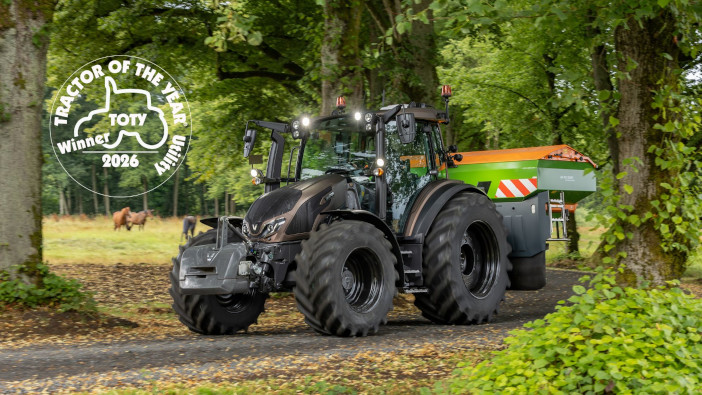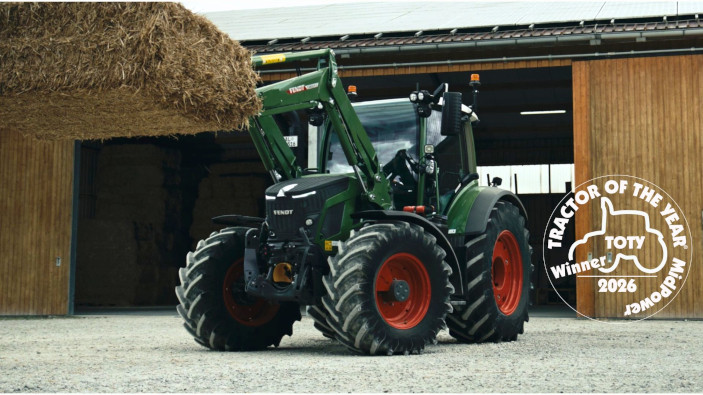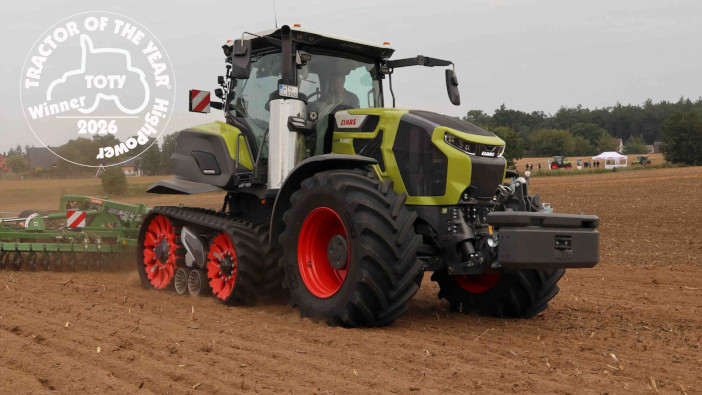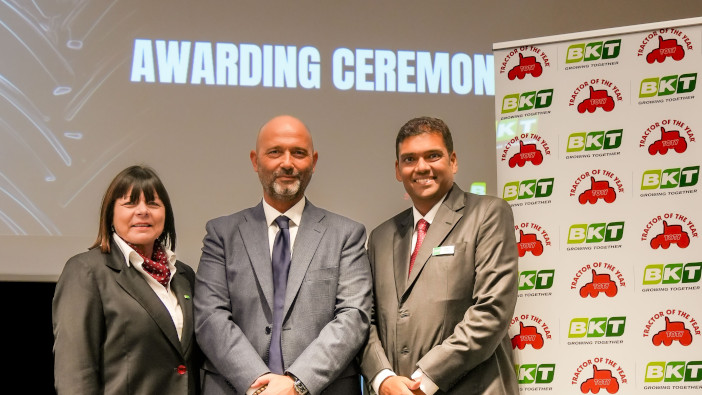On the first day of Agritechnica, the winners of the 2026 Tractor of the Year competition were announced.
TotYBot – AgXeed 2.055W3
Winning the TotYBot award for the second year in a row, AgXeed showcased its autonomous technology with the 2.055 W3.
Designed for operation in orchards and vineyards, this narrow addition to the AgXeed autonomous range boasts a three-wheel design which spreads the weight of the machine and the implement over individual tracks to minimise soil compaction.
It’s powered by a Deutz TCD four-cylinder diesel and HVO-compatible engine, producing 75hp and a maximum of 300Nm of torque at 1,600rpm. The fuel tank is 170 litres, which the company states will provide up to 20hrs of runtime when operating at 75% engine load.
Power is fed into an electronic transmission system, using an Engiro generator and wheel motors provided by Bosch RexRoth. This provides a stepless speed range of 0.1-13.5kph, with a maximum speed of 6kph when being controlled via remote. At the rear, a closed-centre, load-sensing hydraulic system produces up to 85 litres/min, feeding three double-acting, proportional valves. The rear linkage has a maximum capacity of 2.5t, while the pto system has a stepless range from 0 to 1,200rpm.

For safety, it comes with a geofence system and remote supervisory software, enabling operators to monitor and track the unit. A camera system is fitted, as well as Lidar and a front-mounted, cushioned bumper to monitor for obstacles. When an obstacle is found, the machine will stop and wait for the operator to confirm whether to continue work or not.
The jury highlighted the open architecture of its technology, enabling AgXeed to be a truly scalable system, as well as its commercial readiness.
TotY Sustainable – JCB Fastrac 6300
Filling a gap between the 4000 iCON range and the 8000 iCON, JCB has introduced a new two model Fastrac 6000 series, with the flagship joining the HighPower category. It uses an FPT engine, producing 335hp and 1,400Nm of torque, available at 1,400rpm.
Rather than the stepless Agco Vario gearbox, JCB has opted for a ZF Ecom four-range continuously variable transmission, capable of reaching speeds of up to 66kph. Due to the high road speeds, all round, outboard, single calliper disc brakes have been fitted, with ABS as standard.
As the 6000 also has the four-wheel steer seen on the 4000 range, a proportional system has been put in place that gradually reduces the sensitivity of the rear axle as the speed increases, eventually hydraulically locking it in place.

A closed centre, load-sensing hydraulic system is in place, offering 205 litres/min as standard, with the option of a dual pump for 410 litres/min. Up to six electronic spools can be fitted at the rear, with two up front, and the rear linkage can hold up to 11,000kg, while the optional front lift can handle up to 5,000kg.
Finally, a fully integrated central tyre inflation system is available, using a single-line design that expels air into the atmosphere during deflation for quicker response times.
The jury recognised the sustainable benefits that the combination of technology offered within the Fastrac, including the digital connectivity and soil protection.
TotY Specialized – New Holland T4.120 F Auto Command
Designed for professional fruit growers and vineyards, the new T4.120 F Auto Command range packs a lot into a small frame.
It tops out a four-model range, running from 86hp up to 120hp, all powered by a four-cylinder FPT engine which offers 518Nm of torque at just 1,300rpm. When in transport mode, the machine runs in Eco, providing 40kph speeds at 1,500rpm and the maximum speed at 1,780rpm.
A large cooling package has been integrated into the engine compartment, with the option of a reversible fan that can be set to run automatically at timed intervals or can be activated manually.

For operator comfort, hydraulic front axle suspension is equipped, and the standard front axle can be swapped out for a SuperSteer variant that reduces the turning circle from 3.9m to 3.3m. When this is optioned, the fuel capacity of the machine is impacted, with a 95-litre tank equipped instead of the standard 104-litre tank.
At the rear of the machine, the hydraulics package is designed to handle high-power implements. A closed-centre, load-sensing pump provides 115 litres/min to a maximum of five electronic valves at the back, and up to two at the front. The rear linkage has a maximum capacity of 2,520kg, while the optional front linkage can lift up to 1,450kg or 1,480kg when the SuperSteer axle is fitted.
For the jury, it was the combination of the compact frame and premium technology that made this tractor stand out within the vineyard and orchard market.
TotY Utility – Valtra G125 CVT Active
Powered by a four-cylinder AgcoPower engine with a rated power of 120hp, increasing to 130hp with boost, the Valtra G125 features a stepless gearbox, also from Agco, with the ML75 fitted, offering a top speed of 43kph.
The reason for the gearbox change is ease of use, according to the company. Operators can simply jump in the cab and select the direction with the shuttle, with full speed control available via the armrest or the pedal. Two cruising speeds can be set, as well as an engine speed, and the combination of the transmission and engine work automatically to find the most economical settings.

The rest of the tractor will be familiar to Valtra users, with a large, easy-to-access cabin with three wide steps and a handrail up to the door. The hydraulics package includes a closed-centre, load-sensing pump producing 110 litres/min with up to eight mechanical or electronic valves across the front and rear of the machine.
Mechanical cab suspension and hydraulic front axle suspension are available, and the G Series can be specified with the full Valtra Smart Farming suite, including automatic field recognition, Isobus compatibility, auto guidance, section control and variable rate.
The ease of use, stated by the company, was also appreciated by the jury, which also highlighted the agility and user-friendliness of the machine.
TotY MidPower – Fendt 516 Vario
The revamped 500 Vario brings down key features from the high-horsepower range, including the continuously variable VarioDrive TA 120 transmission that automatically and independently adjusts the power sent to each wheel.
This enables all-wheel drive, as well as the pull-in turn effect, which adjusts the speed of the front axle to pull the tractor round, resulting in a turning circle of 10.1m.
The use of the VarioDrive is also a key part of the Fendt iD low speed concept, which enables the AgcoPower Core 50 power unit to run at just 1,300rpm when travelling at 40kph, or at 1,600rpm at the 50kph top speed.

The four-cylinder engine offers a rated power of 164hp, increasing to 174hp with a rated speed of 1,900rpm. Max torque is 792Nm, available continuously between 1,200 and 1,500rpm. Pneumatic braking is fitted to the front and rear, with an electronic trailer brake assist system that monitors the behaviour of the trailer and tractor to avoid jack-knifing.
An electronic load-sensing hydraulic pump is fitted, with 110 litres/min available as standard, increasing to 155 litres/min as an option, with an independent steering pump producing 43 litres/min.
It can also be fitted with the VarioGrip centralised tyre inflation system, as can every wheeled tractor range above the 500 in the Fendt range, using a two-cylinder, water-cooled compressor.
For the jury, the use of technology previously allocated to higher horsepower machines, as well as the tight turning circle and overall versatility, were the key factors.
TotY HighPower – Claas Axion 9.450 Terra Trac
The newly-launched Axion range has five models topping out with the 9.450, which offers a maximum output of 448hp from the FPT Cursor 9 engine. Torque levels on the flagship machine peak at 1,850Nm, available at just 1,400rpm.
A fully stepless ZF transmission puts power to the ground, with a top speed of 50kph, achievable at just 1,650rpm. Torque sensors have been integrated, which Claas states will improve the power management throughout the machine. Droop controls have also been fully automated, and a new casing has been used around the gearbox to limit noise levels in the cabin. Indeed, the company states that sound levels in the cab do not exceed 66dB.
Maintenance, or the cost of maintenance, has been a consideration throughout the development. Service intervals have been increased by 50%, eliminating the 100hr service, with the first being at 750hr. According to the company, this will reduce costs to the user by around 18%.

Of the five models, the flagship and the 9.360 are also available with the Terra Trac rear track system. This remains a key option for the company, especially in the UK and Irish markets, as Patrick notes that 15% of all Terra Trac machines produced globally come over here.
The Terra Trac system has had an overhaul. Two track widths are available of 635mm or 735mm, with the latter providing a footprint of 3.5sq m. The new design is said to reduce the power drag of the tracks by 8hp. The midrollers have a new, flanged design, enabling them to be quickly replaced if required. Each of the idlers also has a clear cap so that oil levels can be visually checked.
Bronze bushes have also been used in the design, replacing the nylon units previously used, and new suspension cylinders have been integrated. To further minimise maintenance around the track units, heavy-duty wear pads have been fitted, and the Terra Trac machines will also include automatic lubrication as standard, available as an option on wheeled machines.
The jury was particularly impressed with the power density and hydraulic output, as well as its strong focus on data-driven farming.


